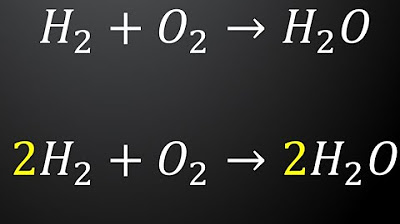The Ideal Gas equation | A level Chemistry
Summary
TLDRThis chemistry video tutorial delves into the ideal gas equation, a fundamental concept in A-Level chemistry. It explains the equation's derivation through everyday examples like party balloons, illustrating how gas behavior relates to temperature (Charles's Law), pressure (Boyle's Law), and the number of gas molecules. The video meticulously covers unit conversions crucial for using the equation correctly, such as converting Pascals, cubic meters, and Kelvin. It also guides through solving practical problems using the ideal gas equation, including calculating moles of gas and applying it to chemical reactions, ensuring a comprehensive understanding of this essential chemistry topic.
Takeaways
- 🎈 The ideal gas equation, PV=nRT, is derived from observing how gases behave under different conditions, such as temperature and pressure changes.
- 🔍 Charles's Law states that the volume of a gas is directly proportional to its temperature (V∝T).
- 📉 Boyle's Law indicates that the pressure of a gas is inversely proportional to its volume (P∝1/V) when temperature is constant.
- 🌡️ The number of moles of a gas is directly proportional to the volume it occupies, which is a fundamental concept in the ideal gas law.
- 📐 The ideal gas equation is applicable to all gases under ideal conditions, regardless of the type of gas.
- ⚖️ The units for the ideal gas equation are crucial: pressure (Pascals), volume (cubic meters), moles (moles), temperature (Kelvin), and the gas constant (8.31 J/K/mol).
- 🔄 Understanding unit conversions is vital for correctly applying the ideal gas equation, especially between Kelvin and Celsius, and cubic meters with other volume units.
- 🔢 The ideal gas equation can be rearranged to solve for different variables, such as pressure, volume, or the number of moles.
- 🧪 Practical applications of the ideal gas equation include calculating moles of gases in reactions, determining temperatures in chemical processes, and finding the molar mass of volatile liquids.
- 🔄 The ideal gas equation can be combined with chemical equations to perform stoichiometric calculations and find the amounts of reactants or products in chemical reactions.
Q & A
What is the ideal gas equation?
-The ideal gas equation is PV = nRT, where P is the pressure, V is the volume, n is the number of moles of gas, R is the gas constant, and T is the temperature in Kelvin.
What is Charles's law as mentioned in the script?
-Charles's law states that the volume of a gas is proportional to its temperature, when the pressure is held constant.
What is Boyle's law and how does it relate to the volume of a gas?
-Boyle's law states that the pressure of a gas is inversely proportional to its volume, provided the temperature and the amount of gas remain constant.
How does the number of moles of gas affect its volume according to the script?
-The volume of a gas is directly proportional to the number of moles of gas it contains, assuming the temperature and pressure are constant.
What does the ideal gas equation assume about the behavior of gases?
-The ideal gas equation assumes that all gases behave in the same ideal way, regardless of their composition, obeying the rules of direct or inverse proportionality with volume, pressure, and temperature.
What is the value of the gas constant R in the ideal gas equation?
-The gas constant R in the ideal gas equation is 8.31 joules per Kelvin per mole.
How can you convert pressure from kilopascals to pascals?
-To convert pressure from kilopascals to pascals, you multiply by 1,000 (since 1 kilopascal is equal to 1,000 pascals).
What is the Kelvin temperature scale and how does it relate to the Celsius scale?
-The Kelvin scale is a temperature scale that starts at absolute zero (0 K) and increases by the same amount as the Celsius scale. To convert Celsius to Kelvin, you add 273.15.
How do you convert cubic centimeters to cubic meters?
-To convert cubic centimeters to cubic meters, you divide by one million, because one cubic meter is equal to one million cubic centimeters.
What is the significance of the units used in the ideal gas equation?
-The units used in the ideal gas equation (Pascals for pressure, cubic meters for volume, Kelvin for temperature) are significant because they ensure the equation's balance and allow for accurate calculations of gas properties.
How can the ideal gas equation be rearranged to solve for different variables?
-The ideal gas equation can be rearranged algebraically to solve for different variables such as pressure (P = nRT/V), volume (V = nRT/P), temperature (T = PV/nR), and the number of moles (n = PV/RT).
Outlines

هذا القسم متوفر فقط للمشتركين. يرجى الترقية للوصول إلى هذه الميزة.
قم بالترقية الآنMindmap

هذا القسم متوفر فقط للمشتركين. يرجى الترقية للوصول إلى هذه الميزة.
قم بالترقية الآنKeywords

هذا القسم متوفر فقط للمشتركين. يرجى الترقية للوصول إلى هذه الميزة.
قم بالترقية الآنHighlights

هذا القسم متوفر فقط للمشتركين. يرجى الترقية للوصول إلى هذه الميزة.
قم بالترقية الآنTranscripts

هذا القسم متوفر فقط للمشتركين. يرجى الترقية للوصول إلى هذه الميزة.
قم بالترقية الآنتصفح المزيد من مقاطع الفيديو ذات الصلة

Ecuación General de los Gases Ideales (PV=nRT)

The Ideal Gas Law: Crash Course Chemistry #12

IB Chemistry Topic 1 Stoichiometric relationships Topic 1.3 Reacting masses and volumes SL

Chemistry: Balancing Chemical Equations (Tagalog Explained)

Konsep mol , ringkasan dan latihan soal

Konsep Mol - Stoikiometri - Perhitungan Kimia - Kimia Kelas 10
5.0 / 5 (0 votes)
